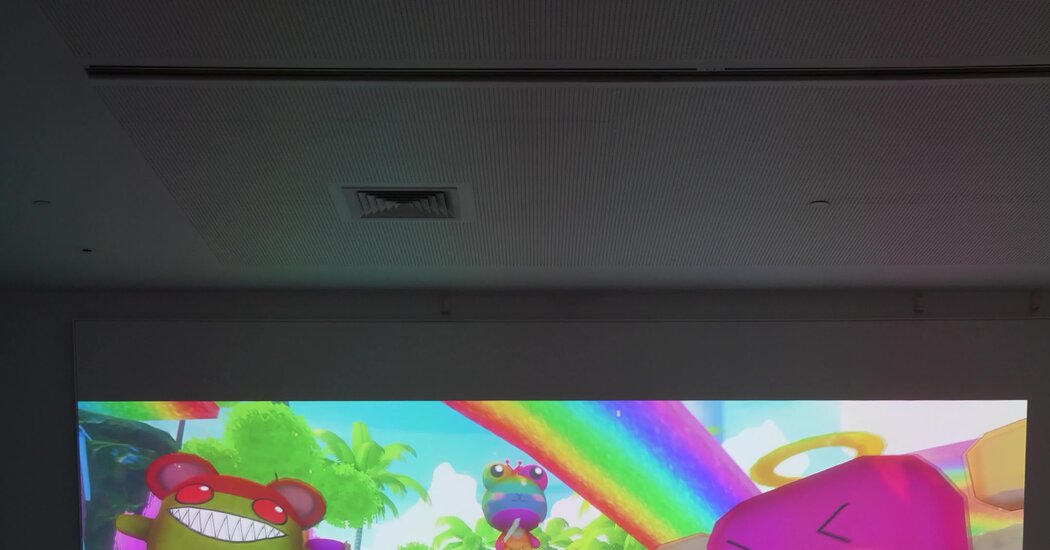
What would it be like to experience life, death and religious enlightenment as a video game or immersive environment? This is what Lu Yang tries to do in two mesmerizing exhibitions, at Amant in Brooklyn and the Museum of the Moving Image in Queens, that channel Buddhist and Indian philosophy into animated and artificial intelligence images.
While A.I. speeds along, upending any number of careers and lives, some in the art world have chosen to embrace it while also, in a sense, subverting it. These artists — for instance, Ian Cheng, Lawrence Lek or Holly Herndon and Mat Dryhurst, many of them Asian, integrate A.I., gaming and other tech-heavy aesthetics into their work.
More important, A.I. is becoming something of a contested medium, like photography was in the 19th- century, when painters were supposed to draw from life, and to be caught using photographs as reference material could damage an artist’s reputation. A.I. is the new technological bugaboo.
Lu Yang is a Shanghai-born artist, who lives in Tokyo. I first saw his work (the artist is gender-neutral and uses he/him pronouns) on the internet, where there are 80 videos by him on Vimeo. Popular ones include “Uterus Man” (2013), which uses Japanese manga and anime, as well as gaming technology and electronic music, to create an androgynous superhero, and “LuYang Delusional Mandala” (2015), which delves into neuroscience and the Buddhist concept of the afterlife.
That same hyper-energy is at the current shows, although with a noticeable vibe shift. His first exhibition in an American museum, “The Great Adventure of Material World” (2019-2020) at Museum of the Moving Image, borrows footage from Lu Yang’s earlier videos and can be experienced either as a 26-minute single-channel video or an interactive video game.
Buddhist levels of consciousness are compared with the skill levels in video games. Here, a character called the Material World Knight moves through the six planes of the bardo — a liminal state between life, death and rebirth — and tries to find the Vajra, a ritual object that often appears as a lightning bolt. The loose but densely packed narrative also includes a funny romp through a kawaii-style (cute) version of heaven.
The video “Doku the Creator” (2025) is an hourlong epic that combines game-engine animation with surrealistic A.I.-generated images of disembodied human and animal organs and Dali-esque landscapes. Lu Yang also dips into classic film, with depictions of himself as a brooding, tormented young man, recalling the noir films of Wong Kar-wai and the frenetic action of Bong Joon Ho.
The first part of the video is a brooding meditation on art world success, — the value of art, fame, collecting and creation itself. Art history is described as a Lego set in which the pieces are rearranged and novelty is a myth. As an example of current art world spectacles, Lu Yang includes footage of his own project in 2023, in which “Doku” footage appeared on 100 screens in Times Square at midnight for several nights.
What we’re really seeing, I think, is two things: Artists confronting the age of A.I., and art world burnout. Like photography in the 19th century, which was seen as a “forbidden” medium, A.I. is the new concern when it comes to generating so-called original art images. Lu Yang uses it but credits its use in the wall labels accompanying the work to Doku: the avatar rather than the artist. The attribution seems to suggest at least some ambivalence — or maybe it is more intentional confusion.
One solution, presented in Lu Yang’s videos, is to exist solely in the digital realm, where the artist can create, as he argues here, with “unlimited freedom,” aided by A.I., and unconfined by “stylistic labels.”
A second solution comes in the form of just the opposite: traditional religion. At the Amant exhibition, piles of stones line the courtyard, evoking devotional “mani” cairns in Tibetan Buddhism, which are placed along mountain paths. Prayer scrolls hang here too, inscribed with short lines attributed to the Tibetan Buddhist Dzogchen Pema Tashi Rinpoche: “May I become a refuge and guide for all sentient beings,” reads one; “A healer and medicine for the sick, a support and a ferry for those without refuge,” says another.
A preternaturally talented artist, Lu Yang is at an impasse. There is a pathos to the Amant installation that is, in many ways, timeless: an artist confronting the demands — and emptiness — of worldly success, and grasping ancient wisdom as the world hurtles forward. Like a novice contemplating reincarnation with a video game controller in hand, he seeks the Vajra and enters new realms.
His earlier videos were shorter — usually 10 to 15 minutes — and the long-form works here get lost in the weeds sometimes, resembling sermons retooled for the digital age. But he suggests that the old tools can also be refashioned as new tools: “A friend to the lonely, a helper to the helpless,” the prayer on the wall reads, an unexpected panacea in a video exhibition.
Lu Yang, Doku! Doku! Doku! samsara.exe
Through Feb. 15, 2026, at Amant, 315 Maujer Street, Brooklyn; amant.org.
Lu Yang: The Great Adventure of Material World
Through March 22, 2026, Museum of the Moving Image, 36-01 35 Avenue, Queens; 718-777-6800, movingimage.org.